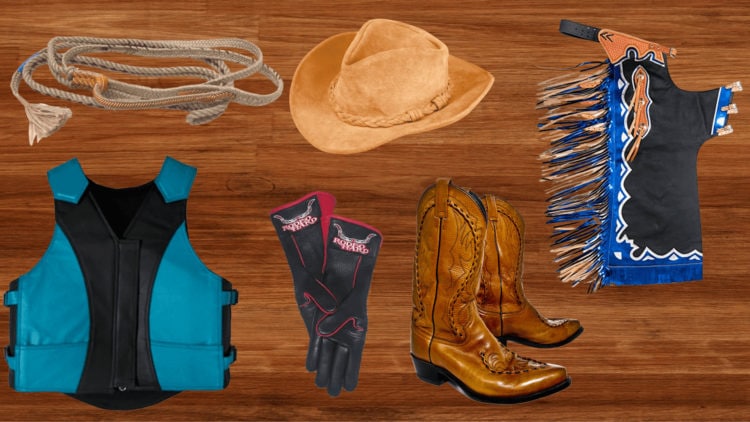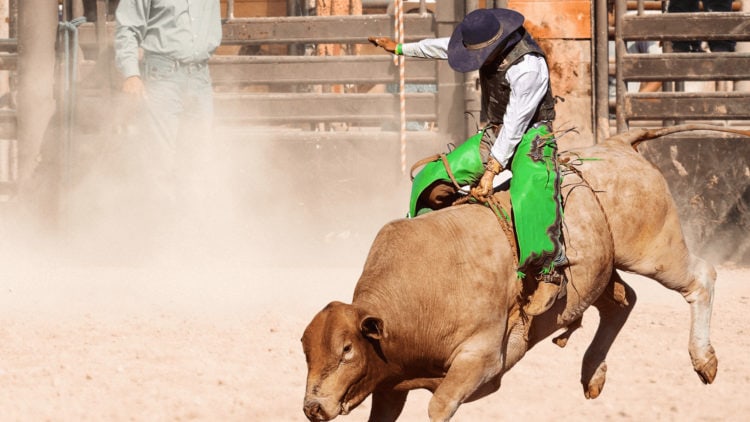
OBJECTIVE OF BULL RIDING: Successfully ride a bull for eight seconds, scoring as many points as possible by utilizing proper technique.
NUMBER OF PLAYERS: 1+ player(s)
MATERIALS: Bull rope, gloves, vest, cowboy boots, chaps, helmets
TYPE OF GAME: Sport
AUDIENCE: 16+
OVERVIEW OF BULL RIDING
Bull riding is an extremely fast-paced and dangerous sport that sees athletes attempting to ride a jumping and jerking bull for at least eight seconds straight. While extremely popular in the United States and Mexico, bull riding has garnered substantial international interest in past decades, particularly in South American and Oceanic countries.
Unbeknown to most, bull riding is a tradition that dates back thousands of years to the island of Crete, the home of the Minoan civilization. However, the Minoans focused more on the taming of bulls, not specifically the riding aspect.
The popularized idea of saddling a bull for entertainment was actually the work of the 16th and 17th-century Mexicans, who chose to ride bulls in the middle of a bullfighting event (a jaripeo).
Bull riding was introduced to the United States in the 1800s when people started riding young castrated bulls known as “steer”. However, the public appeal of these competitions was never great, possibly because the steer simply weren’t violent enough.
The public opinion of Americans concerning bull riding completely changed in the early 1900s when steers were once again replaced with actual bulls. This led to two major bull-riding associations being formed in the later 1900s: the Professional Rodeo Cowboys Association (PRCA) which was originally called Rodeo Cowboy Association (RCA) founded in 1936, and Professional Bull Riders (PBR). These two leagues hold hundreds of competitions every year in the United States, many of which are broadcast on national television.
SETUP

EQUIPMENT
Bull Rope: A braided rope handle constructed of nylon and grass. The rider can only hold onto the bull with this one handle. This rope wraps around the bull in such a manner that it encourages the bull to move violently.
Helmet: While optional, helmets are becoming increasingly encouraged due to the horrific injuries associated with the sport. Some riders choose to wear a traditional cowboy hat instead of a helmet.
Vest: A protective vest is worn by most riders to protect their torso in case the bull tramples them while on the ground.
Gloves: Gloves are worn to maintain a better grip on the bull rope and reduce instances of rope burn.
Chaps: Loose-fitting leather protectors, called “chaps”, are worn over a rider’s pants to provide further protection for the lower body.
Cowboy Boots: Cowboy boots have a sole that features a deep ridge that allows riders greater control over the riding spurs.
THE RODEO
Bull riding competitions are often referred to as “rodeos”. These events take place in sizeable arenas that feature a wide-open rectangular area of dirt on which the riders compete.
Riders mount their bulls in makeshift stables known as “bucking chutes”, which line one end of the competition area. These bucking chutes have three tall walls and a large metal gate from which the bulls enter and exit.
These arenas also contain multiple exits to which the bulls are supposed to run after a rider is thrown off the saddle.
The middle competition area is lined with seven-foot-high fencing supported by metal rods for audience safety. This prevents the bull from breaking through the fence and endangering the crowd. Similarly, this height allows riders to jump on top of the fence in case a bull continues to chase them.
BULLFIGHTERS
Bullfighters, often referred to as “rodeo clowns”, are individuals who wear bright clothing and attempt to distract the bull when a rider is thrown off. Usually present in groups of three, these bullfighters are wholly responsible for the safety of the riders, as a 1500-pound rampaging bull can easily cause irreversible damage to a rider who is on the ground.
At some venues, bullfighters also act as secondary entertainment to the show, filling in the gaps in action between bull rides.
GAMEPLAY

SCORING
Upon exiting the bucking chute, a rider must remain on the bull’s back for a full eight seconds to receive a score. A rider is scored both on his technique and the bull’s ferocity. Both the rider and the bull receive a score.
A rider is scored out of 50 points on the following criteria:
- Constant control and rhythm
- Movements matched with those of the bull’s
- Spurring/control of the bull
A bull is scored out of 50 points based on the following criteria:
- Overall agility, power, and speed
- Quality of back leg kicks
- Quality of front-end drops
While a rider only scores if they can successfully fulfil an eight second ride, a bull is scored for every run. This is primarily because the highest-scoring bulls are brought back for important competitions, notably finals.
Most competitions will have between 2-4 judges responsible for judging either the bull or the rider, with their scores combined and averaged. A top score of 100 can be achieved, although scores in the 90s are considered exceptional.
Wade Leslie is the only bull rider who has ever achieved a perfect 100-point score with his ride in 1991, although most people consider it only to be an 85-point ride by today’s standards.
Depending on the competition, most riders only ride one bull per day. After multiple days of competition, the highest-scoring riders (often 20 riders) take one last ride to determine a winner.
RIDING RULES
Unsurprisingly, the sport of bull riding has very few rules. However, one major rule that cannot be broken makes the sport incredibly hard: only one hand can be on the bull rope at all times. This means that after a rider mounts, they can only hold on with one predetermined arm throughout the ride. Meanwhile, the other arm is often held up in the air.
If a bull rider touches the bull or saddle with their free arm, an action termed “slapping”, their run is disqualified, and they do not receive a score.
In the event of equipment failure or unordinary behavior from the bull, a rider is allowed a re ride if approved by the judges.
END OF GAME
The rider with the highest combined the rider score and bull score at the end of the competition is deemed the winner. Typically, this final score is based on a single ride performed by riders who qualified for the “short-go”, or the final round.
- 30 GAMES TO PLAY OVER TEXT - April 22, 2024
- 20+ FREE PRINTABLE BABY SHOWER GAMES - April 16, 2024
- 20+ College Party Games for the Best Night Ever! - April 2, 2024